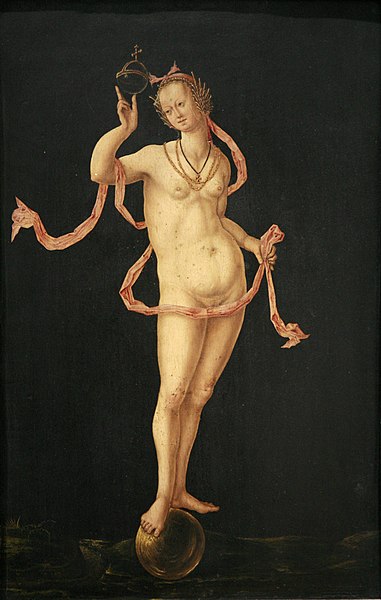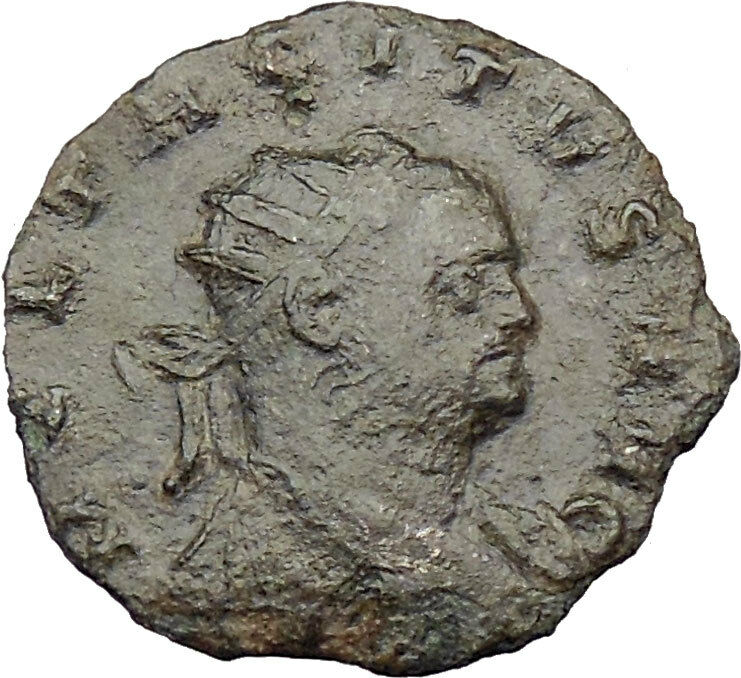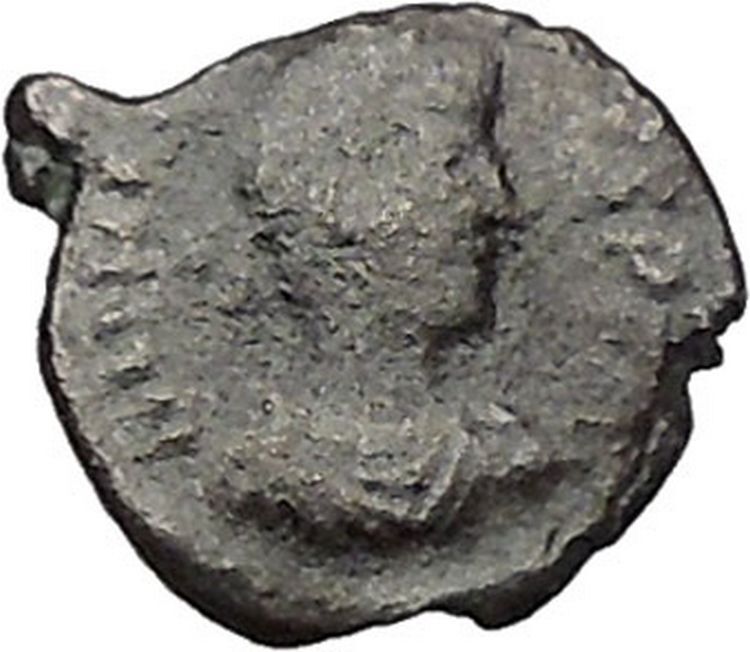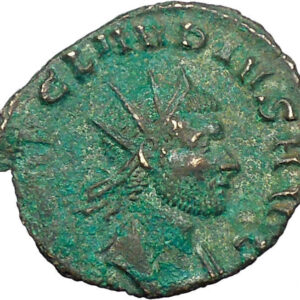|
Septimius Severus
–
Roman Emperor
: 193-211 A.D. –
Silver Denarius 18mm (3.01 grams) Rome mint 199 A.D.
Reference: RIC 136, S 6332, C 452
LSEPTSEVAVGIMPXIPARTMAX – Laureate head right.
PMTRPVIICOSIIPP – Fortuna, towered and draped, holding rudder and an
inverse
cornucopia above a galley on her left, at her feet.
You are bidding on the exact item pictured,
provided with a Certificate of Authenticity and Lifetime Guarantee of
Authenticity.

Fortuna lightly balances the
orb
of sovereignty between thumb
and finger in a Dutch painting of ca 1530
(Musée
des Beaux-Arts de Strasbourg)
Fortuna (Latin:
Fortūna, equivalent to the
Greek
goddess
Tyche
) was the goddess of fortune and
personification
of
luck in
Roman religion
. She might bring good luck or
bad: she could be represented as veiled and blind, as in modern depictions of
Justice
, and came to represent life’s
capriciousness. She was also a goddess of
fate
: as Atrox Fortuna, she claimed the
young lives of the
princeps
Augustus
‘ grandsons
Gaius
and
Lucius
, prospective heirs to the Empire.[1]
Her father was said to be Jupiter and like him, she could also be bountiful (Copia[disambiguation
needed]). As
Annonaria
she protected grain supplies.
June 11 was sacred to her: on June 24 she was given cult at the festival of
Fors Fortuna
.[2][3]
Cult

Fortuna and Pontos
Fortuna’s Roman cult was variously attributed to
Servius Tullius
– whose exceptional good
fortune suggested their sexual intimacy[4]
– and to
Ancus Marcius
.[5]
The two earliest temples mentioned in Roman Calendars were outside the city, on
the right bank of the Tiber (in Italian
Trastevere
). The first temple dedicated to Fors
was attributed to the Etruscan Servius Tullius, while the second is known to
have been built in 293 BC as the fulfilment of a Roman promise made during later
Etruscan wars
[6]
The date of dedication of her temples was 24 June, or Midsummer’s Day, when
celebrants from Rome annually floated to the temples downstream from the city.
After undisclosed rituals they then rowed back, garlanded and inebriated.[7]
Also Fortuna had a temple at the
Forum Boarium
. Here Fortuna was twinned with
the cult of
Mater Matuta
(the goddesses shared a festival
on 11 June), and the paired temples have been revealed in the excavation beside
the church of
Sant’Omobono
: the cults are indeed archaic in
date.[8]
Fortuna Primigenia of
Praeneste
was adopted by Romans at the end of
3rd BC in an important cult of Fortuna Publica Populi Romani (the
Official Good Luck of the Roman People) on the
Quirinalis
outside the
Porta Collina
.[9]
No temple at Rome, however, rivalled the magnificence of the Praenestine
sanctuary.
Fortuna’s identity as personification of chance events was closely tied to
virtus
(strength of character). Public
officials who lacked virtues invited ill-fortune on themselves and Rome:
Sallust
uses the infamous
Catiline
as illustration – “Truly, when in the
place of work, idleness, in place of the
spirit of measure and equity
, caprice and pride
invade, fortune is changed just as with morality”.[10]
An oracle
at the
Temple of Fortuna Primigena
in
Praeneste
used a form of divination in which a
small boy picked out one of various futures that were written on
oak
rods. Cults to Fortuna in her many forms are attested throughout the Roman
world. Dedications have been found to Fortuna Dubia (doubtful fortune),
Fortuna Brevis (fickle or wayward fortune) and Fortuna Mala (bad
fortune).
She is found in a variety of domestic and personal contexts. During the early
Empire, an amulet from the
House of Menander
in
Pompeii
links her to the Egyptian goddess
Isis, as Isis-Fortuna.[11]
She is functionally related to the God
Bonus Eventus
,[12]
who is often represented as her counterpart: both appear on
amulets
and intaglio
engraved gems
across the Roman world.
Her name seems to derive from Vortumna (she who revolves the year).[citation
needed]
The earliest reference to
the Wheel of Fortune
, emblematic of the endless
changes in life between prosperity and disaster, is from 55 BC.[13]
In
Seneca
‘s tragedy Agamemnon, a chorus
addresses Fortuna in terms that would remain almost proverbial, and in a high
heroic ranting mode that Renaissance writers would emulate:
“O Fortune, who dost bestow the throne’s high boon with mocking hand, in
dangerous and doubtful state thou settest the too exalted. Never have
sceptres obtained calm peace or certain tenure; care on care weighs them
down, and ever do fresh storms vex their souls. …great kingdoms sink
of their own weight, and Fortune gives way ‘neath the burden of herself.
Sails swollen with favouring breezes fear blasts too strongly theirs;
the tower which rears its head to the very clouds is beaten by rainy
Auster
…. Whatever Fortune has raised
on high, she lifts but to bring low. Modest estate has longer life; then
happy he whoe’er, content with the common lot, with safe breeze hugs the
shore, and, fearing to trust his skiff to the wider sea, with
unambitious oar keeps close to land.”[14]
Ovid
‘s description is typical of Roman
representations: in a letter from exile[15]
he reflects ruefully on the “goddess who admits by her unsteady wheel her own
fickleness; she always has its apex beneath her swaying foot.”
Middle Ages
Fortuna did not disappear from the popular imagination with the ascendancy of
Christianity by any means.[16]
Saint Augustine
took a stand against her
continuing presence, in the
City of God
: “How, therefore, is she good,
who without discernment comes to both the good and to the bad? …It profits one
nothing to worship her if she is truly fortune… let the bad worship
her…this supposed deity”.[17]
In the 6th century, the
Consolation of Philosophy
, by statesman and
philosopher
Boethius
, written while he faced execution,
reflected the Christian theology of casus, that the apparently random and
often ruinous turns of Fortune’s Wheel are in fact both inevitable and
providential, that even the most coincidental events are part of God’s hidden
plan which one should not resist or try to change. Fortuna, then, was a servant
of God,[18]
and events, individual decisions, the
influence of the stars
were all merely vehicles
of Divine Will. In succeeding generations Boethius’ Consolation was
required reading for scholars and students. Fortune crept back in to popular
acceptance, with a new iconographic trait, “two-faced Fortune”, Fortuna
bifrons; such depictions continue into the 15th century.[19]

Albrecht Dürer
‘s engraving of
Fortuna, ca 1502
The ubiquitous image of
the Wheel of Fortune
found throughout the
Middle Ages and beyond was a direct legacy of the second book of Boethius’s
Consolation. The Wheel appears in many renditions from tiny miniatures in
manuscripts
to huge stained glass windows in
cathedrals, such as at
Amiens
. Lady Fortune is usually represented as
larger than life to underscore her importance. The wheel characteristically has
four shelves, or stages of life, with four human figures, usually labeled on the
left regnabo (I shall reign), on the top regno (I reign) and is
usually crowned, descending on the right regnavi (I have reigned) and the
lowly figure on the bottom is marked sum sine regno (I have no kingdom).
Medieval representations of Fortune emphasize her duality and instability, such
as two faces side by side like
Janus
; one face smiling the other frowning;
half the face white the other black; she may be blindfolded but without scales,
blind to justice. She was associated with the
cornucopia
, ship’s rudder, the ball and the
wheel. The cornucopia is where plenty flows from, the Helmsman’s rudder steers
fate, the globe symbolizes chance (who gets good or bad luck), and the wheel
symbolizes that luck, good or bad, never lasts.
Fortune would have many influences in cultural works throughout the Middle
Ages. In
Le Roman de la Rose
, Fortune frustrates the
hopes of a lover who has been helped by a personified character “Reason”. In
Dante’s
Inferno
(vii.67-96)
Virgil
explains the nature of Fortune, both a
devil and a ministering angel, subservient to God.
Boccaccio
‘s De Casibus Virorum Illustrium
(“The Fortunes of Famous Men”), used by
John Lydgate
to compose his
Fall of Princes
, tells of many where the
turn of Fortune’s wheel brought those most high to disaster, and Boccaccio essay
De remedii dell’una e dell’altra Fortuna, depends upon Boethius for the
double nature of Fortuna. Fortune makes her appearance in
Carmina Burana
(see image). The
Christianized Lady Fortune is not autonomous: illustrations for Boccaccio’s
Remedii show Fortuna enthroned in a triumphal car with reins that lead to
heaven,[20]
and appears in chapter 25 of Machiavelli’s
The Prince
, in which he says Fortune only
rules one half of men’s fate, the other half being of their own will.
Machiavelli reminds the reader that Fortune is a woman, that she favours a
strong, or even violent hand, and that she favours the more aggressive and bold
young man than a timid elder. Even
Shakespeare
was no stranger to Lady Fortune:
- When in disgrace with Fortune and men’s eyes
- I all alone beweep my outcast state … —
Sonnet 29
Pars Fortuna in
Astrology

llustration by Al-Biruni (973-1048) of different phases of the moon,
from the Persian Kitab al-tafhim
In Astrology
the term ‘Pars Fortuna’ represents a
mathematical point in the
zodiac
derived by the longitudinal positions of
the Sun
,
Moon and
Ascendant
(Rising sign) in the birth chart of
an individual. It represents an especially beneficial point in the horoscopic
chart. In
Arabic
Astrology
, this point is called
Arabian Parts
.[21]
The procedure followed for fixing one’s Pars Fortuna in ancient and
traditional astrology depended on the time of birth, viz., during daylight or
night time (whether the Sun was above or below the
horizon
). In modern
western astrology
the day time formula only was
used for many years, but with more knowledge of ancient astrology, the two
calculation methods are now often used.
The formula for calculating the day time Part of Fortune (PF) is (using the
360 degree positions for each point):
PF = Ascendant + Moon
–
Sun
The formula for the night-time Part of Fortune is PF = Ascendant + Sun – Moon
Each calculation method results in a different
zodiac
position for the
Part of Fortune
.[22]
Al Biruni
(973 – 1048), an 11th-century
mathematician, astronomer and scholar, who was the greatest proponent of this
system of prediction, listed a total of 97 Arabic Parts, which were widely used
for astrological consultations. Paul Vachier has prepared an Arabic Parts
Calculator for all the Arabic Parts.
L ucius Septimius Severus (or rarely Severus I) (April 11, ucius Septimius Severus (or rarely Severus I) (April 11,
145/146-February 4, 211) was a
Roman
general, and
Roman
Emperor
from April 14, 193 to 211. He was born in what is now the
Berber
part of
Rome’s historic
Africa Province
.
Septimius Severus was born and raised at
Leptis
Magna
(modern Berber
, southeast of
Carthage
,
modern Tunisia
).
Severus came from a wealthy, distinguished family of
equestrian
rank. Severus was of
Italian
Roman ancestry on his mother’s side and of
Punic
or
Libyan
-Punic
ancestry on his father’s. Little is known of his father,
Publius Septimius Geta
, who held no major political status but had two
cousins who served as consuls under emperor
Antoninus Pius
. His mother, Fulvia Pia’s family moved from
Italy
to
North
Africa
and was of the
Fulvius
gens,
an ancient and politically influential clan, which was originally of
plebeian
status. His siblings were a younger
Publius Septimius Geta
and Septimia Octavilla. Severus’s maternal cousin was
Praetorian Guard
and consul
Gaius Fulvius Plautianus
.
In 172, Severus was made a
Senator
by the then emperor
Marcus Aurelius
. In 187 he married secondly
Julia
Domna
. In 190 Severus became
consul
, and in
the following year received from the emperor
Commodus
(successor to Marcus Aurelius) the command of the
legions
in Pannonia
.
On the murder of
Pertinax
by
the troops in 193, they proclaimed Severus Emperor at
Carnuntum
,
whereupon he hurried to Italy. The former emperor,
Didius Julianus
, was condemned to death by the Senate and killed, and
Severus took possession of Rome without opposition.
The legions of
Syria
, however, had proclaimed
Pescennius Niger
emperor. At the same time, Severus felt it was reasonable
to offer
Clodius Albinus
, the powerful governor of Britannia who had probably
supported Didius against him, the rank of Caesar, which implied some claim to
succession. With his rearguard safe, he moved to the East and crushed Niger’s
forces at the
Battle of Issus
. The following year was devoted to suppressing Mesopotamia
and other Parthian vassals who had backed Niger. When afterwards Severus
declared openly his son
Caracalla
as successor, Albinus was hailed emperor by his troops and moved to Gallia.
Severus, after a short stay in Rome, moved northwards to meet him. On
February
19
, 197
,
in the
Battle of Lugdunum
, with an army of 100,000 men, mostly composed of
Illyrian
,
Moesian
and
Dacian
legions,
Severus defeated and killed Clodius Albinus, securing his full control over the
Empire.
Emperor
Severus was at heart a
soldier
, and
sought glory through military exploits. In 197 he waged a brief and successful
war against the
Parthian Empire
in retaliation for the support given to Pescennius Niger.
The Parthian capital
Ctesiphon
was sacked by the legions, and the northern half of
Mesopotamia
was restored to Rome.
His relations with the
Roman
Senate
were never good. He was unpopular with them from the outset, having
seized power with the help of the military, and he returned the sentiment.
Severus ordered the execution of dozens of Senators on charges of corruption and
conspiracy
against him, replacing them with his own favorites.
He also disbanded the
Praetorian Guard
and replaced it with one of his own, made up of 50,000
loyal soldiers mainly camped at
Albanum
, near Rome (also probably to grant the emperor a kind of centralized
reserve). During his reign the number of legions was also increased from 25/30
to 33. He also increased the number of auxiliary corps (numerii), many of
these troops coming from the Eastern borders. Additionally the annual wage for a
soldier was raised from 300 to 500
denarii
.
Although his actions turned Rome into a military
dictatorship
, he was popular with the citizens of Rome, having stamped out
the rampant corruption of Commodus’s reign. When he returned from his victory
over the Parthians, he erected the
Arch of Septimius Severus
in Rome.
According to Cassius Dio,
however, after 197 Severus fell heavily under the influence of his Praetorian
Prefect,
Gaius Fulvius Plautianus
, who came to have almost total control of most
branches of the imperial administration. Plautianus’s daughter,
Fulvia Plautilla
, was married to Severus’s son, Caracalla. Plautianus’s
excessive power came to an end in 205, when he was denounced by the Emperor’s
dying brother and killed.
The two following praefecti, including the jurist
Aemilius Papinianus
, received however even larger powers.
Campaigns in Caledonia (Scotland)
Starting from 208 Severus undertook a number of military actions in
Roman
Britain
, reconstructing
Hadrian’s Wall
and campaigning in
Scotland
.
He reached the area of the
Moray
Firth
in his last campaign in Caledonia, as was called Scotland by
the Romans..
In 210 obtained a peace with the
Picts
that lasted
practically until the final withdrawal of the Roman legions from Britain,
before falling severely ill in
Eboracum
(York).
Death
He is famously said to have given the advice to his sons: “Be harmonious,
enrich the soldiers, and scorn all other men” before he died at Eboracum on
February 4
,
211. Upon his death in 211, Severus was
deified
by the Senate and succeeded by his sons,
Caracalla
and
Geta
, who were advised by his wife
Julia
Domna
. The stability Severus provided the Empire was soon gone under their reign.
Accomplishments and Record
Though his military expenditure was costly to the empire, Severus was the
strong, able ruler that Rome needed at the time. He began a tradition of
effective emperors elevated solely by the military. His policy of an expanded
and better-rewarded army was criticized by his contemporary
Dio Cassius
and
Herodianus
: in particular, they pointed out the increasing burden (in the
form of taxes and services) the civilian population had to bear to maintain the
new army.
Severus was also distinguished for his buildings. Apart from the triumphal
arch in the Roman Forum carrying his full name, he also built the
Septizodium
in Rome and enriched greatly his native city of
Leptis
Magna
(including another triumphal arch on the occasion of his visit of
203).
Severus and Christianity
Christians were
persecuted
during the reign of Septimus Severus. Severus allowed the
enforcement of policies already long-established, which meant that Roman
authorities did not intentionally seek out Christians, but when people were
accused of being Christians they could either curse
Jesus
and make an
offering to
Roman gods
, or be executed. Furthermore, wishing to strengthen the peace by
encouraging religious harmony through
syncretism
,
Severus tried to limit the spread of the two quarrelsome groups who refused to
yield to syncretism by outlawing
conversion
to Christianity or
Judaism
.
Individual officials availed themselves of the laws to proceed with rigor
against the Christians. Naturally the emperor, with his strict conception of
law, did not hinder such partial persecution, which took place in
Egypt
and the
Thebaid
, as
well as in
Africa proconsularis
and the East. Christian
martyrs
were
numerous in Alexandria
(cf.
Clement of Alexandria
, Stromata, ii. 20;
Eusebius
, Church History, V., xxvi., VI., i.). No less severe were
the persecutions in Africa, which seem to have begun in 197 or 198 (cf.
Tertullian’s
Ad martyres), and included the Christians known in the
Roman martyrology
as the martyrs of
Madaura
.
Probably in 202 or 203
Felicitas
and
Perpetua
suffered for their faith. Persecution again raged for a short time
under the proconsul
Scapula
in
211, especially in
Numidia
and
Mauritania
.
Later accounts of a Gallic
persecution, especially at
Lyon, are
legendary. In general it may thus be said that the position of the Christians
under Septimius Severus was the same as under the
Antonines
;
but the law of this Emperor at least shows clearly that the
rescript
of
Trajan
[
neededclarification] had failed to execute its purpose.
|









 ucius Septimius Severus (or rarely Severus I) (April 11,
ucius Septimius Severus (or rarely Severus I) (April 11, 


